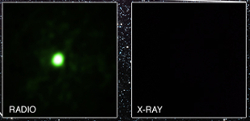 HEAPOW: What You Don't See (2016 Jul 25)
HEAPOW: What You Don't See (2016 Jul 25)
Sometimes what you don't see can be as important as what you do see. This may be especially true for finding black holes. Black holes can exist in orbit around another star, and there are estimated to be up to 10,000 such such black hole binaries in just the Milky Way galaxy. Currently, only 19 black hole binary systems have been confirmed by astronomers, with another 60 candidate systems identified. The discrepancy between the expected number and the observed number suggests that there is a large number of black hole systems that are difficult to find. Most black hole systems have been identified by their high, and highly variable, X-ray emission, produced when the black hole swallows material from its companion. But if the companion is not actively transferring matter to the black hole, there's very little X-ray emission. Black hole binary systems also show characteristic emission in the radio part of the electromagnetic spectrum. One unusual radio source, called VLA J2130+12, was discovered in radio observations near the Milky Way globular cluster M15. Subsequent radio observations showed that VLA J2130+12 is actually a nearby source in front of M15, and its radio emission also suggested that the source was probably some type of accreting binary system. X-ray observations with the Chandra X-ray Observatory, however, failed to detect the source, putting a very low upper limit to its X-ray emission. The combination of the radio observations, the Chandra X-ray observations, and optical pictures of the source taken with the Hubble Space Telescope strongly suggest that VLA J2130+12 is a black hole binary system, with little accretion and therefore little X-ray emission. Analysis of these data suggest the system may have an usually short orbital period (of perhaps 1-2 hours), and its spatial location above the plane of our Galaxy suggests that it received a large kick when the black hole progenitor exploded as a supernova. It also suggest that there may be a large number of such "quiescent" black hole binary systems lurking in the Milky Way. Of course, single black holes are much harder to detect than black hole binaries; how many of them are out there?
CXC: VLA J2130+12: Clandestine Black Hole May Represent New Population
http://asterisk.apod.com/viewtopic.php?t=36097
| << Previous HEAPOW | High Energy Astrophysics Picture of the Week | Next HEAPOW >> |